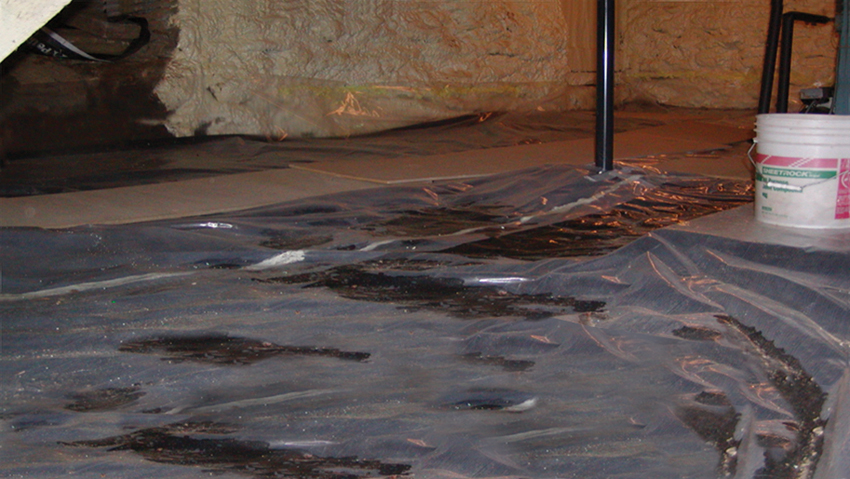The Building Science of Floor Systems
Vented Crawl Spaces
Section R408.1 of the IRC first addresses ventilation. It requires 1 square foot of ventilation for each 150 square feet of under-floor area. If a Class I vapor barrier is used on the floor (i.e., 0.1 perm or less, such as polyethylene film, foil-faced insulation, aluminum foil, etc.), the ventilation requirement is reduced by a factor of 10—down to 1 square foot of ventilation for each 1,500 square feet of under-floor area. This can be interpreted to acknowledge the importance of creating a barrier between vapor evaporating from the ground and the space. In either case, there is a requirement stating that “one such ventilating opening shall be within 3 feet of each corner of the building.”
Section R408.2 goes on to describe six types of acceptable materials and their thicknesses that can be used to cover the ventilation openings, including sheet metal plates, grill/grating, bricks, hardware cloth, and corrosion-resistant wire mesh. It also clarifies the exception for the 1:1,500 square feet ventilation when a vapor barrier is used, indicating that the required openings must provide cross ventilation of the space. It also allows the use of operable louvers. These provisions make it clear how to design and specify crawl space ventilation to comply with the code. Of course, like most code requirements, these are minimum provisions that rely on the design professional to create the most appropriate design for a building. These provisions also assume that the ventilation is a solution applicable to all locations without taking into account that warm, moist air enters through the ventilation openings and may condense on cooler surfaces in the space.
Unvented Crawl spaces
The code does not end here. In fact, it allows for unvented crawl spaces to be constructed in R408.3 when certain conditions are met. The first requirement here is that “exposed earth is covered with a continuous Class I vapor retarder” as required for reducing the ventilation-opening area above. However, for unvented crawl spaces, the requirements are increased in that “joints of the vapor retarder shall overlap by 6 inches and shall be sealed or taped.” This is a straight-forward detail that makes a notable difference in stopping moisture. The requirement continues, stating, “The edges of the vapor retarder shall extend not less than 6 inches up the stem wall and shall be attached and sealed to the stem wall or insulation.” This provision assures the edges and all penetrations of the vapor retarder are addressed to provide fully continuous protection against ground moisture.

Photo courtesy of Huber Engineered Woods, LLC
Class I vapor retarders in unvented crawl spaces need to have seams and edges taped, and the retarder needs to extend at least 6 inches up all walls, piers, and other protrusions.
An unvented crawl space must also comply with an additional requirement beyond the Class I vapor retarder described above. The IRC allows the designer to pick any one of the following options.
- Mechanical exhaust ventilation: This must operate continuously, connect to the conditioned space via a duct or transfer grille, and move air at the rate of 1 cubic foot per minute for each 50 square feet of crawl space area. In addition, the walls (not the ceiling) of the crawl space must be insulated.
- Conditioned air supply: Instead of simply exhausting air, conditioned air can be supplied and exhausted by design following all of the same parameters as for mechanical exhaust ventilation above, including the insulation requirements. This essentially creates an enclosed, conditioned space under the floor.
- Plenum: If the under-floor space is used as an air plenum for the building, this is allowed, as long as all of the requirements for a plenum are met. Section M1601.5.1 covers these requirements, and the first thing it points out is that such under-floor plenums are no longer allowed in new construction. The provisions are for modifications or repairs to such plenums in existing buildings only.
- Dehumidification: A new provision in the 2018 code allows for the dehumidification of the space (i.e., removing the moisture) at the rate of 70 pints (8.75 gallons) per day for every 1,000 square feet of space. Of course, this water needs a place to drain away to and must be part of the design.
Taking the unvented crawl space approach is clearly allowed, but it moves the line of the building enclosure from the crawl space ceiling (floor construction above) to the perimeter walls and the ground line. IECC 2018 is also okay with this approach with requirements that mesh directly with those above. Section R402.2.11 of IECC 2018 identifies the requirements of eliminating the ventilation, permanently attaching the insulation, and providing a Class I vapor retarder in the same manner as called for in unvented crawl spaces. Essentially, this approach treats an unvented crawl space similarly to a basement in terms of thermal performance and moisture control, while addressing some of the common differences in construction between the two.









